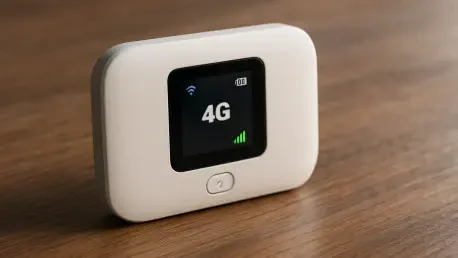In an era where remote work and constant connectivity define professional life, the ability to access a stable internet connection while traveling has become a non-negotiable need for many. Picture a business traveler rushing through a crowded airport, desperate to join a critical virtual meeting, only to find that public Wi-Fi is sluggish or insecure, and smartphone tethering rapidly drains data limits. This scenario underscores a growing challenge for professionals on the move, prompting curiosity about alternative solutions like portable 4G hotspots. These compact devices, designed to create personal Wi-Fi networks via cellular towers, promise to bridge the gap between mobility and productivity. Through rigorous real-world testing of a specific model, the JourneyGo 4G Hotspot, in diverse California environments, this exploration aims to uncover whether such technology can truly meet the demands of work travel, from handling urgent emails to supporting seamless video calls.
The appeal of portable 4G hotspots lies in their potential to deliver a secure, independent internet source without the risks associated with public networks or the constraints of smartphone plans. Testing revealed a mixed bag of results, shaped heavily by location and network conditions. In bustling urban settings, performance often faltered under the weight of interference, raising doubts about reliability during peak times. Yet, in quieter areas, the experience transformed, offering speeds capable of supporting high-definition streaming and uninterrupted browsing. Beyond connectivity, additional features like power bank functionality add practical value, though limitations in battery life and charging speed temper expectations. With flexible pricing and subscription models, these devices cater to sporadic travelers, but their situational effectiveness demands careful consideration. This analysis dives deeper into each aspect to provide a clear picture for professionals weighing their options for staying connected on the road.
Understanding Portable 4G Hotspots
Defining the Technology and Its Appeal
Portable 4G hotspots have emerged as a compelling solution for professionals seeking reliable internet access during work travel, offering a personal Wi-Fi network by leveraging cellular tower connections. Unlike public Wi-Fi, which often poses security risks and inconsistent speeds, or smartphone tethering, which can quickly exhaust data plans and battery life, these devices create a dedicated network for multiple gadgets. Their compact design, often no larger than a small puck, ensures easy portability, fitting seamlessly into a laptop bag or pocket. The growing demand for such technology stems from the increasing reliance on cloud-based tools, virtual meetings, and real-time collaboration, all of which require stable connectivity. For business travelers, avoiding exorbitant roaming fees or unreliable hotel networks makes these hotspots an attractive alternative, promising both convenience and security in environments where staying online is critical to productivity.
The significance of portable 4G hotspots extends beyond mere convenience, addressing a broader shift toward mobile workforces that operate across diverse locations and need reliable internet access. These devices can support up to 10 simultaneous connections, accommodating laptops, tablets, and smartphones without the need to juggle multiple data plans. This capability is particularly valuable for teams traveling together or individuals managing several devices for work and personal use. Additionally, the setup process is often streamlined, requiring minimal technical know-how—just a quick activation and a data plan subscription can get users online in minutes. However, while the concept sounds ideal, real-world performance varies widely based on external factors like network congestion and signal strength. Understanding these nuances is essential for professionals considering whether such a device can reliably meet their needs during critical travel scenarios, especially in high-stakes situations demanding uninterrupted access.
Why Professionals Are Turning to Hotspots
For many professionals, the unpredictability of internet access while traveling has long been a source of frustration, driving interest in portable 4G hotspots as a dependable workaround. Public Wi-Fi networks, often found in airports, cafes, or hotels, frequently suffer from overcrowding, leading to slow speeds or dropped connections at the worst possible moments. Moreover, security concerns loom large, as these open networks can expose sensitive work data to potential breaches. Smartphone tethering, while a quick fix, often results in rapid battery drain and data overage charges, especially during extended trips. Portable hotspots offer a middle ground, providing a controlled, private connection that mitigates these risks and allows users to maintain productivity without compromising on security or facing unexpected costs, making them a practical choice for frequent travelers.
Another key reason behind the rising adoption of portable 4G hotspots among professionals is the flexibility they provide in managing connectivity needs across varied travel itineraries. Whether attending a conference in a bustling city or working from a remote retreat, the ability to carry a personal internet source ensures consistency that other options often lack. This is particularly beneficial for roles requiring constant access to large files, real-time collaboration tools, or video conferencing platforms, where even brief disruptions can derail progress. Furthermore, the avoidance of long-term commitments with data plans tailored to short-term use aligns well with the sporadic nature of business travel. As the workforce continues to embrace remote and hybrid models, the demand for such portable solutions is likely to grow, positioning 4G hotspots as a vital tool for maintaining seamless communication and workflow efficiency in dynamic, on-the-go environments.
Performance in Real-World Scenarios
Navigating Challenges in Busy Areas
Testing the JourneyGo 4G Hotspot in high-traffic environments, such as near busy urban intersections in California, revealed significant challenges that could impact its suitability for work travel. Network congestion from numerous competing devices often led to frustratingly slow internet speeds, sometimes dipping as low as 2.3 Mbps for downloads and 1.39 Mbps for uploads. This sluggish performance made tasks like uploading large files or joining video calls nearly impossible without interruptions. Connection drops further compounded the issue, disrupting workflows at critical moments. For professionals relying on consistent access in crowded cities or peak travel hubs like airports, these limitations highlight a notable drawback. The interference in such settings suggests that while the concept of a portable hotspot is promising, its reliability in dense, urban areas may not always meet the demands of time-sensitive work.
Beyond the raw speed numbers, the practical implications of using a portable 4G hotspot in high-traffic zones point to a clear need for contingency plans among business travelers. When tested during peak hours, the device struggled to maintain a stable connection, often requiring multiple reconnection attempts, which wasted valuable time. This inconsistency could prove problematic for tasks requiring real-time interaction, such as live presentations or client meetings conducted over video platforms. Even basic browsing felt cumbersome, with pages loading at a snail’s pace compared to standard home Wi-Fi. For those whose travel often involves bustling metropolitan areas or crowded venues, these performance hiccups indicate that relying solely on a 4G hotspot might pose risks to productivity. Exploring backup options, like pre-downloading essential files or identifying secure Wi-Fi alternatives, becomes crucial in such scenarios to mitigate potential disruptions.
Excelling in Quieter Settings
In stark contrast to urban challenges, the JourneyGo 4G Hotspot delivered impressive results when tested in low-traffic environments, such as late at night in less populated California areas. Under these conditions, the device provided a near-home Wi-Fi experience, with speeds robust enough to handle seamless browsing, streaming high-definition content up to 4K, and even supporting online gaming without noticeable lag. This level of performance proved ideal for work tasks like drafting reports, accessing cloud-based documents, or participating in video conferences without fear of interruptions. The absence of network congestion allowed the hotspot to showcase its full potential, making it a reliable companion for professionals traveling to quieter destinations or working during off-peak hours when interference is minimal, thus ensuring that critical deadlines are met with ease.
The reliability in low-traffic settings also extends to versatility, catering to a range of activities beyond strict work demands, which adds to the device’s appeal for travelers. Streaming services like Netflix operated smoothly at high resolutions, providing a welcome break during downtime without draining data excessively. Additionally, multiplayer online games ran without connectivity hiccups, a testament to the stable signal strength in these environments. For business travelers who often find themselves in suburban or rural locations—perhaps for retreats, site visits, or client meetings in less crowded regions—this performance offers reassurance that productivity won’t be compromised. The ability to maintain a consistent connection under such conditions positions portable 4G hotspots as a valuable asset, provided the travel itinerary aligns with environments where network interference is unlikely to pose a barrier to effective use.
Additional Features and Practicality
Power Bank Utility for Travelers
One standout aspect of the JourneyGo 4G Hotspot is its dual functionality as a power bank, adding a layer of practicality for those constantly on the move, especially during travel or remote work. While not a primary feature, this capability allows users to charge devices like smartphones or tablets directly from the hotspot, reducing the need to carry additional gadgets. However, the charging speed is relatively modest—testing showed it took around 30 minutes to boost a phone’s battery from 15% to 30%. This slow pace means it’s better suited for topping off devices during downtime rather than serving as an emergency power source. For business travelers aiming to pack light, this feature provides a small but tangible benefit, offering a backup option when outlets are scarce, though expectations should be tempered regarding its speed and capacity compared to dedicated power banks.
The power bank functionality, while useful, also reveals certain trade-offs that travelers should consider when evaluating the overall utility of the device. Its limited charging output means it’s not a replacement for high-capacity portable chargers, especially during long travel days filled with heavy device usage. Additionally, using the hotspot to charge another device can impact its primary function, potentially draining its battery faster and reducing the time available for internet connectivity. This interplay between features underscores the importance of prioritizing needs—whether internet access or device power takes precedence during a trip. For professionals who frequently find themselves in situations with limited access to charging stations, this added functionality can still serve as a handy supplement, provided they plan usage carefully to balance both connectivity and power demands without running into unexpected shortages.
Battery Life Under Different Workloads
Battery performance is a critical factor when assessing the practicality of portable 4G hotspots for work travel, and the JourneyGo’s endurance varies significantly based on usage intensity. Under light conditions, such as streaming content on a single laptop or casual browsing, the device can last up to 20 hours on a full charge, offering ample runtime for a full day of intermittent use. This longevity is ideal for travelers with moderate connectivity needs, ensuring they can stay online through meetings or email checks without constantly searching for a power source. However, this duration assumes minimal device connections and lower data demands, which may not reflect the reality for all users. Understanding this baseline helps set realistic expectations for trips where access to charging might be limited, allowing for better planning around work schedules.
In contrast, during heavy usage scenarios—such as supporting multiple devices or engaging in data-intensive tasks like video streaming and large file downloads—the battery life of the JourneyGo drops to around 13 hours. This reduction can pose challenges for professionals on extended workdays or long flights where recharging isn’t an option. The drain becomes particularly noticeable when juggling several connected gadgets, a common scenario for those managing both personal and work devices simultaneously. For such users, anticipating shorter battery life under high workloads is essential to avoid mid-task disruptions. Carrying a backup power source or scheduling downtime for recharging becomes a necessary strategy to maintain uninterrupted access. This variability in endurance highlights the importance of aligning device capabilities with specific travel and work patterns to ensure it meets demands without unexpected hiccups.
Cost and Flexibility for Travelers
Breaking Down Pricing and Data Plans
The financial aspect of adopting a portable 4G hotspot like the JourneyGo plays a significant role in determining its suitability for work travel, with costs structured to accommodate varying needs and preferences. The device itself retails at $199, though it’s occasionally available on sale for $159, representing a reasonable upfront investment for a multi-functional gadget. Data plans, provided through TravlFi, range widely from a budget-friendly $19 per month for 2GB to a premium $129 for unlimited data, catering to both light users and those with heavy connectivity demands. This tiered pricing allows travelers to select a plan that matches their anticipated usage, whether for short trips requiring minimal data or extended journeys necessitating constant access. The absence of hidden fees or mandatory long-term contracts further enhances the appeal, making the cost structure transparent for professionals evaluating their budget for travel tech.
Delving deeper into the pricing model, the range of data plans ensures that users aren’t locked into paying for more than they need, which is a critical consideration for sporadic travelers who may only require occasional connectivity. For instance, the lower-tier plans suit those who primarily need connectivity for emails and basic browsing during brief business trips, while the unlimited option targets users reliant on streaming, large file transfers, or multi-device setups. However, the higher-end plan’s $129 monthly cost might deter budget-conscious individuals unless their work consistently demands high data volumes. Comparing this to potential roaming charges or overage fees from smartphone plans, the investment can often prove cost-effective, especially for international travel. Professionals must weigh these costs against their typical data consumption and travel frequency to determine if the expense aligns with the value of uninterrupted connectivity, ensuring they maximize benefits without overspending on unused capacity.
Advantages of a Flexible Subscription Model
The subscription model associated with the JourneyGo 4G Hotspot stands out for its pay-as-you-go flexibility, a feature tailored to the unpredictable nature of work travel. Unlike traditional internet or mobile plans that often require annual commitments, this approach allows users to activate and cancel service as needed, paying only for the months they use. This is particularly advantageous for professionals whose travel schedules fluctuate, ensuring they aren’t burdened with ongoing costs during periods of minimal or no travel. The ability to scale data plans up or down based on upcoming trips further customizes the experience, offering control over expenses. For those who only require connectivity for specific projects or seasonal travel, this model minimizes financial risk while providing access to a reliable internet solution when it matters most.
Additionally, the lack of long-term obligations in the subscription framework empowers users to adapt to changing work demands without penalty, enhancing its practicality for dynamic professional lifestyles. If a sudden business trip arises, activating a plan for just that duration becomes a hassle-free process, avoiding the complexity of negotiating temporary service with other providers. Conversely, during extended periods at a home base with stable Wi-Fi, canceling the plan prevents unnecessary charges, aligning costs directly with usage. This adaptability also encourages experimentation—travelers can test different data tiers to find the sweet spot for their needs without fear of being locked in. For companies equipping teams with connectivity tools, this flexibility can streamline budget planning, ensuring resources are allocated efficiently. Ultimately, the subscription model’s design reflects an understanding of modern travel patterns, offering a low-barrier entry point for professionals seeking dependable internet access on their terms.
Reflecting on Practical Solutions
Looking back, the evaluation of the JourneyGo 4G Hotspot across diverse settings painted a nuanced picture of its reliability for work travel, with performance highs in quiet areas juxtaposed against struggles in crowded zones. The journey through California’s varied environments underscored how situational factors like network congestion dictated the device’s effectiveness for professional needs. Battery life fluctuations and modest power bank capabilities added layers of consideration, while the flexible pricing and subscription options provided a financial framework that adapted to sporadic use. These insights, grounded in real-world application, highlighted that while portable 4G hotspots hold significant potential, their value hinges on aligning with specific travel contexts and work demands.
Moving forward, professionals considering such devices should prioritize assessing their typical travel environments to gauge potential performance outcomes, opting for hotspots as primary tools only in low-traffic scenarios or as backups in urban settings. Exploring hybrid strategies, such as combining hotspot use with pre-downloaded materials for critical tasks, can offset reliability gaps in congested areas. Additionally, factoring in battery management plans, like carrying supplementary chargers for intensive days, ensures uninterrupted access. For those intrigued by the cost flexibility, starting with a lower-tier data plan offers a low-risk way to test the waters before committing to higher investments. Ultimately, portable 4G hotspots stand as a promising asset for the mobile workforce, provided users tailor expectations and strategies to maximize their strengths while navigating inherent limitations.









